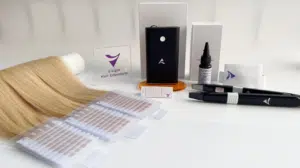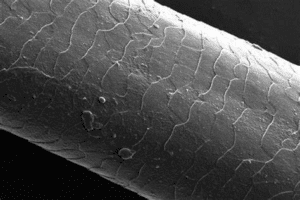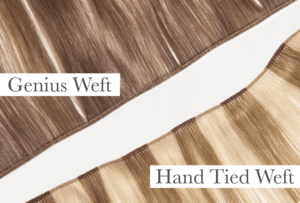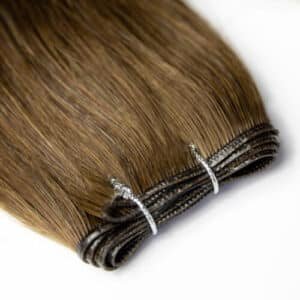Confused by nano rings? You’re not alone. Clients ask about comfort, visibility, and longevity. Let’s break it down in plain, salon-ready language.
Nano ring hair extensions are strand-by-strand, bead-secured additions. Pros: tiny and discreet, no glue, reusable hair, good movement. Cons: time-intensive installs, frequent maintenance, tricky brush care, not ideal for very fragile hair.
I supply hair to pro stylists and salons, so I see what lasts and what fails. Below is a practical guide you can use in the chair, on your training days, and with clients who want facts—not fluff.

What are nano hair extensions?
Clients want invisible bonds and a light feel. Nanos promise both, but terms get mixed up. Here’s a clear definition.
Nano hair extensions are tiny strand units attached with metal or copper nano rings (with a silicone liner) to small sections of natural hair—no heat, no glue.
Core structure
A “nano tip” bundle holds 0.5–1.0g of hair on average. The tip is usually a fine metal loop or a compact keratin/metal composite designed to slip into a nano ring. The ring’s inner diameter is smaller than classic micro rings, so the bond sits flatter and hides better in fine or medium hair.
How the attachment works
A stylist sections a tiny strand of the client’s hair, threads it and the nano tip into a small ring, then compresses the ring with pliers. The silicone sleeve grips without slipping and cushions the natural hair. No adhesive means no solvent for removal; you open the ring and slide out the tip.

Where nanos fit best
Nanos are popular for part lines, crowns, and face-framing areas because the beads are discreet. They blend well in layered cuts and on clients who wear hair up. For very dense or very curly hair, some stylists prefer keratin bonds or wefts for speed and distribution.
Hair quality matters more than the method
We manufacture full cuticle, single-donor hair because it behaves like healthy hair. Lower-grade hair (non-Remy with mixed cuticles) tangles early, regardless of the attachment method. If you are a salon owner, you already know the method gets blamed when the raw material is the real culprit.
Pros of nano hair extensions?
Stylists choose nanos for one simple reason: stealth. The second reason is control strand by strand.
Pros include: ultra-discreet bonds, no heat or glue, flexible placement, easy removals, reusable hair, and customizable density per zone.
Discretion and comfort
The bead is tiny, so bonds sit close to the scalp without bulky profile. Clients who tuck hair behind the ears or wear half-up styles like nanos because they show less. Proper tension and clean sectioning reduce scalp awareness after the first 48 hours.
No chemical remover
With nanos, removals are mechanical. You open the ring and slide out the tip. This protects color clients and sensitive scalps. It also speeds up re-application days because you can reuse clean hair if the ends are still fresh.
Density control
Because nanos are single strands, you can feather density around cowlicks, blend into fine temple hair, and build weight gradually toward the back. This gives better movement than a single heavy weft on some heads.
Maintenance flexibility
Move-ups typically happen every 6–8 weeks, but you can spot-service areas that grow faster, like the nape. If a client loses a few strands, you replace just those—not an entire row.

Cons of nano hair extensions?
Every method has trade-offs. Nanos are no exception. Expect time and detail work.
Cons include: longer install times, frequent maintenance, risk of slippage with oily or very fine hair, special brushing habits, and small-parting limitations.
Time and labor
A full head can mean 100–200+ strands. Precise sectioning and even tension take time. For busy salons, chair time affects pricing and scheduling. Educate clients about this at consultation.
Slippage and product conflicts
Heavy conditioner, oils at the scalp, or frequent use of silicone serums near bonds can cause slip. Gym clients who sweat daily may need tighter follow-ups. Teach “condition mids-to-ends only” and dry bonds after workouts.
Brush and snag risk
Clients must use an extension-safe loop brush and support bonds with the other hand when detangling. Aggressive brushing, snagging with nails, or sleeping with loose hair will create tangles at the bead line.
Not ideal for severely fragile hair
Very compromised hair (post-bleach breakage or active shedding) may not hold tiny bonds safely. In those cases, consider a temporary system (halo or clip-ins) while the hair recovers, or move to a lighter-density plan.
Nano ring hair extensions installation?
Good installs look simple. They aren’t. They are systems. Tools, sectioning, and tension decide the outcome.
Step-by-step: consult, map density, prep and cleanse, section clean grids, load rings, insert tips, compress, check row balance, blend cut, and educate aftercare.
1) Consultation and mapping
Review hair health, medical history, oil production, swim and gym habits, parting patterns, and styling goals. Map high-visibility zones (temples, crown) and avoid tension-sensitive areas. Decide strand count and gram weight per zone.
2) Prep
Clarify the natural hair at the root area to remove oils and slip-agents. No heavy masks near the scalp pre-install. Blow-dry smooth for clean sectioning. Pre-tone extension hair if you need micro-tone adjustments for ultra-precise matches.
3) Tools and materials
You need nano rings with silicone linings, nano tip strands, loop tool or crochet hook, fine tail comb, pliers made for micro/nano beads, sectioning clips, and an extension brush. Keep color-coded bead trays so you can match darker and lighter roots.
4) Sectioning technique
Create clean, brick-lay patterns with even spacing. Leave safe margins around hairlines and part lines. Keep strands similar in size to the natural hair section—too much extension hair on too little natural hair causes tension and rotation.
5) Apply and compress
Thread the natural strand through the ring, add the nano tip, seat it, then compress once with the pliers at the correct angle. Do not over-crimp; you can cut the silicone and cause slip. Align all bonds to lay flat with the fall of the hair.
6) Quality check
Gently tug-test random bonds. Check rows for even distribution. Confirm that the client can change parting without exposing bonds. Add or subtract strands where needed.
7) Blend and finish
Point-cut or slide-cut to blend. Add internal layers for movement. Heat style only after you confirm bond integrity. Photograph for records and future move-ups.
8) Aftercare briefing
Show the client how to brush, how to shampoo (roots carefully, condition mids-to-ends), and how to sleep (loose braid or silk scrunchie). Book the 6–8 week maintenance before they leave.
How long do nano hair extensions last?
Clients hear many numbers. Set clear expectations up front.
One application lasts 6–8 weeks before a move-up. The hair itself can last 6–12 months with premium full cuticle stock and correct care.
Application longevity vs. hair lifespan
These are different. The application window ends when regrowth lowers bonds too far from the scalp. At 6–8 weeks, you remove and re-seat higher. The hair we supply—full cuticle, single donor—can be reinstalled many times. Lower-grade nonremy hair may matte early and shorten usable life.
Factors that shorten wear
Excess oils on the root, heavy conditioners at the scalp, hard water mineral buildup, tight ponytails that torque the bead, and skipping nightly braids all cut the timeline. Color corrections performed after install can also stress both bond and fiber.
Realistic salon plan
Tell clients to budget for move-ups every 6–8 weeks, clarifying treat-and-reset days, and periodic end-trims to keep the set fresh. If a client swims often or trains daily, recommend 5–6 week intervals for best appearance.
Nano hair extensions before and after?
Results sell themselves, but context matters. Good “after” shots come from good planning.
Measure wins by blend, density balance, part-line invisibility, and movement—not only length. Track with standardized photos.
What to capture
Shoot front, profile, back, and crown under the same light and background. Document natural hair length, density, and condition. After install, show ponytail, tucked-behind-ear, and half-up angles so clients see bond stealth in real life.
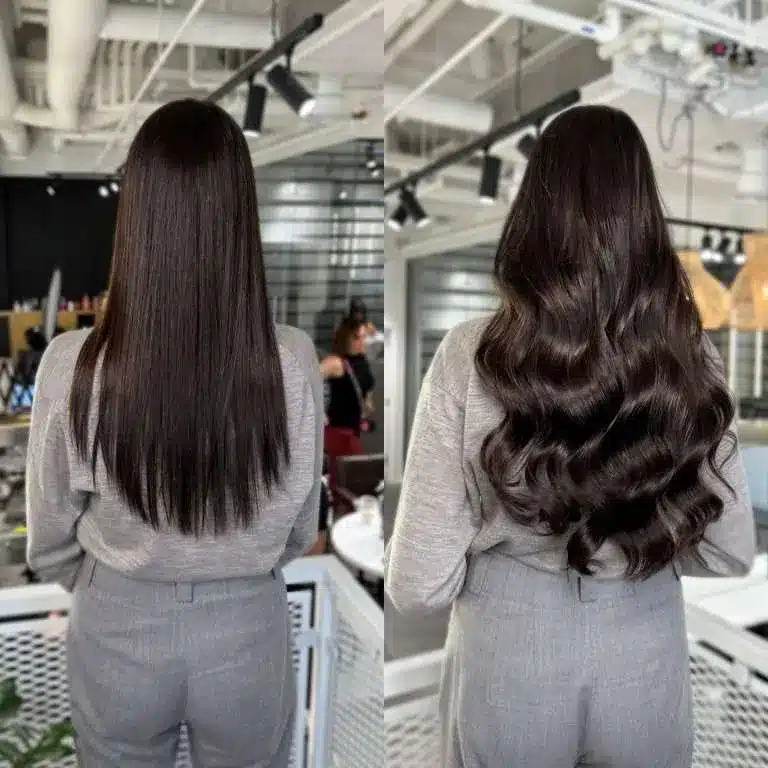
What “good” looks like
You should see a seamless color melt, a believable perimeter, and internal layers that move with the natural hair. The density should match the client’s head size and neck length; too much hair looks costume-like.
Troubleshooting check-list
If you see shelf lines at the perimeter, reduce gram weight at the bottom rows or add micro layers. If bonds flash through on the crown, rebalance spacing and follow the client’s true part. If movement looks stiff, remove bulk in the mid-shaft and soften the ends.

Nano rings vs. micro rings: what’s the difference?
Clients hear both names and think they’re the same. They are not.
Nanos use smaller beads and tips, sit flatter, and hide better in fine hair. Micros are larger, faster to apply, and suit medium-to-dense hair.
Bead and tip size
Nano beads are smaller in inner diameter and pair with ultra-fine tips. This makes them discreet but also more sensitive to product slip. Micro beads are bigger and can grab larger natural sections, which may help on dense hair.
Application speed and maintenance
Micros can be slightly faster due to larger sectioning, but they may show more in fine, low-density zones. Nanos take longer but reward you with stealth near part lines and hairlines. Maintenance intervals are similar; product discipline is stricter with nanos.
Comfort and suitability
Fine-haired clients often prefer nanos for comfort and cosmetic stealth. Athletes or very active clients with dense hair may prefer micro for durability and ease of spot replacement. Both methods avoid adhesives and solvents.
My opinion
I operate as a manufacturer and supplier.In my view, nano ring hair extensions are best when:
- the client needs invisible bonds around part lines,
- the stylist wants full control strand by strand,
- the salon can support 6–8 week maintenance.
When budgets are tight on chair time, or the hair is very fragile, I suggest a lighter-density plan or a different method. Hair quality drives outcomes more than the attachment. Full cuticle, single-donor hair remains the best value per wear cycle.
FAQ
Are nano hair extensions damaging?
With proper section size, correct tension, and disciplined aftercare, nanos are low-damage. Problems come from too-heavy strands on too-fine hair, rough brushing, or overdue maintenance.
How many grams do I need for a full head?
Typical ranges: 80–100g for fine hair, 120–160g for medium, 180–200g+ for thick or length jumps. Always map by zone, not only by total grams.
Can I color nano extensions?
You can gloss or tone professional human hair extensions. Avoid lightening after install. Pre-tone off-head before application for precision.
Do nano rings set off airport scanners?
No. The beads are tiny and do not trigger standard security scanners.
Can I wear my hair up with nanos?
Yes. Keep enough margin from the hairline and crown. Your stylist should place stealth strands around likely partings and updos.
What shampoo should I use?
Use a gentle, sulfate-free cleanser. Keep conditioners and masks on mids-to-ends. Avoid oils and heavy serums at the root where beads sit.
What if a few strands slip?
Book a quick fix. Replace lost strands and review product use at the root. Small spot services keep the set tidy between full move-ups.
Nano vs keratin bonds—what’s safer?
Both are safe when applied correctly. Nanos avoid heat and removers. Keratin bonds are lighter per point and very secure on active clients. Choose based on hair condition and lifestyle.
Conclusion
Nano ring hair extensions offer discreet bonds, strong customization, and clean removals. Plan installs well, use premium full cuticle hair, teach strict aftercare, and book 6–8 week maintenance for consistent, camera-ready results.
Nano Ring Hair Extensions

